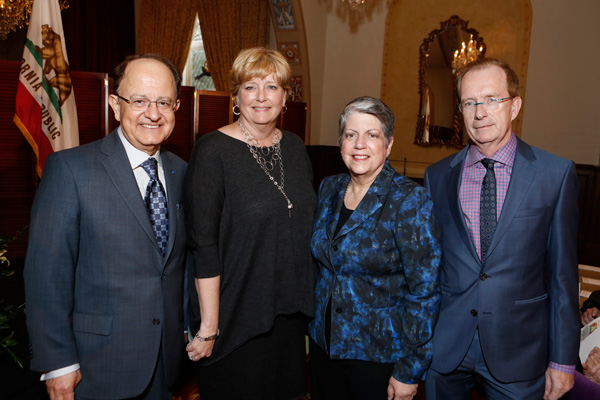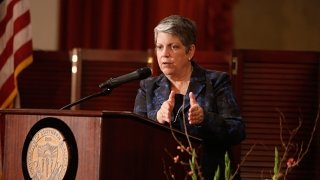Janet Napolitano does her homework. When USC Rossier’s Pullias Center for Higher Education invited her to deliver its 37th Annual Lecture, the president of the University of California prepared for the assignment by reading the Pullias Lectures of two of her predecessors, David P. Gardner and Richard Atkinson, the former UC presidents who delivered the 1988 and 1997 lectures, respectively.
With her talk on Wednesday evening, “A Trifecta for the Future: Higher Education, California and Innovation,” Napolitano added her name to the long list of nationally recognized scholars and academic leaders who have delivered the annual address named in honor of Earl V. Pullias, one of the founding faculty members of USC’s Department of Higher Education in 1957. Napolitano served as secretary of the U.S. Department of Homeland Security from 2009 to 2013 and as governor of Arizona from 2003 to 2009.
“What has changed at the University of California is not the cost of producing an education,” she said. “It is the amount of the cost borne by students.”
“President Napolitano is trying to forge a conversation with California citizens about what kind of state we want,” says William G. Tierney, co-director of the Pullias Center and the Wilbur Kieffer Professor of Higher Education at USC Rossier. “She’s arguing persuasively that a full-employment, high-skills economy requires a first-class public system of higher education.”
Napolitano set the context for her remarks by summarizing the messages of her two predecessors. As the Cold War was drawing to its conclusion in 1988, Gardner had spoken of the ways global transformation would internationalize the reach and mission of America’s research universities. And a decade later, Atkinson had lamented a public that did not understand the true value of research universities, calling for a passionate conversation about higher education that recognizes that “the discovery and application of knowledge are not at the periphery but at the heart of what research universities are about.”
Napolitano picked up where Atkinson left off, saying that California’s passionate conversation “needs to focus on the unique role research universities have played in making California a bastion of innovation and a world leader in its own right.”
Bearing the Costs of a Public Higher Education
Napolitano’s nod to Atkinson allowed her to share a startling fact with an audience eager for her to say something about the recent tuition hikes at the University of California. She would get there, but first she would share this: “Today, the University of California is funded by the state in constant dollars at the same level as it was in 1997, the very year President Atkinson came here to plead for a better public understanding of the myriad and vast contributions research universities make to California.”
This support has remained level for a 10-campus University of California system that has 75,000 more students since 1997, the equivalent of adding two more universities the size of UCLA.
Napolitano then explained that despite public perception, the cost of producing a degree has not gone up since 1997. Instead, the University of California has grappled with a 30 percent decrease in state support since the economic recession of 2008.
“What has changed at the University of California is not the cost of producing an education,” she said. “It is the amount of the cost borne by students.”
It was in this context that she announced that the University of California would put planned tuition increases on hold, at least through the summer session, as it waits to see how budget negotiations play out with Governor Jerry Brown and state legislators.
Napolitano said, “It is my most fervent hope that we will be able to reach a funding accord with Sacramento that will be significant enough to forestall any in-state tuition increase for at least the next academic year.”

Innovation through Collaboration between Public and Private Universities
“Our negotiations are not about just dollars,” said Napolitano. “They are about a down payment on California’s future. Full investment in the university is ultimately a full investment in the California Dream.”
Napolitano evoked the sentiments of a November op-ed by Thomas F. Rosenbaum and John L. Hennessy, the respective presidents of Caltech and Stanford who put forward a counterintuitive plea to reinvest in public higher education.
“Our campuses and the University of California are partners in making the state of California the economic and innovation powerhouse it is today,” said Napolitano in quoting directly from Rosenbaum and Hennessy. “Much of the world-class research conducted on our campuses is inextricably linked with research emanating from the University of California. If California is to remain an economic dynamo, then it needs the full capability of its research universities to be well supported.”
Napolitano concluded by citing several examples of collaborations between the state’s public and private universities, including the USC/UCLA Center on Biodemography and Public Health, which is housed on both campuses; a three-way partnership between UC Irvine, the UCLA Stroke Center at Ronald Reagan UCLA Medical Center and the USC Comprehensive Stroke and Cerebrovascular Center at Keck Medicine of USC; and a three-way partnership between USC, UCLA and Caltech to form an innovation hub funded by the National Science Foundation.
“We may hash it out on the football field as spirited rivals,” said Napolitano, “but when it comes to research and education, the relationships between these research universities—public and private—are far more seamless and symbiotic.”




